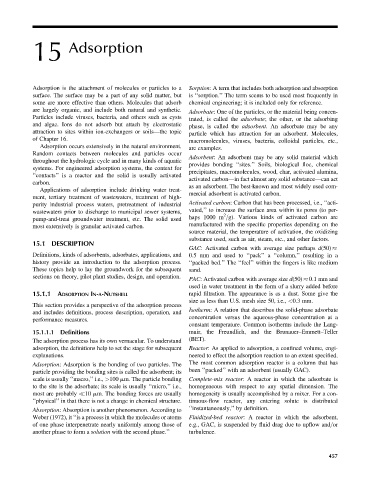Page 502 - Fundamentals of Water Treatment Unit Processes : Physical, Chemical, and Biological
P. 502
15 Adsorption
Adsorption is the attachment of molecules or particles to a Sorption: A term that includes both adsorption and absorption
surface. The surface may be a part of any solid matter, but is ‘‘sorption.’’ The term seems to be used most frequently in
some are more effective than others. Molecules that adsorb chemical engineering; it is included only for reference.
are largely organic, and include both natural and synthetic. Adsorbate: One of the particles, or the material being concen-
Particles include viruses, bacteria, and others such as cysts trated, is called the adsorbate; the other, or the adsorbing
and algae. Ions do not adsorb but attach by electrostatic phase, is called the adsorbent. An adsorbate may be any
attraction to sites within ion-exchangers or soils—the topic particle which has attraction for an adsorbent. Molecules,
of Chapter 16. macromolecules, viruses, bacteria, colloidal particles, etc.,
Adsorption occurs extensively in the natural environment. are examples.
Random contacts between molecules and particles occur
Adsorbent: An adsorbent may be any solid material which
throughout the hydrologic cycle and in many kinds of aquatic
provides bonding ‘‘sites.’’ Soils, biological floc, chemical
systems. For engineered adsorption systems, the context for
precipitates, macromolecules, wood, char, activated alumina,
‘‘contacts’’ is a reactor and the solid is usually activated
activated carbon—in fact almost any solid substance—can act
carbon.
as an adsorbent. The best-known and most widely used com-
Applications of adsorption include drinking water treat-
mercial adsorbent is activated carbon.
ment, tertiary treatment of wastewaters, treatment of high-
purity industrial process waters, pretreatment of industrial Activated carbon: Carbon that has been processed, i.e., ‘‘acti-
wastewaters prior to discharge to municipal sewer systems, vated,’’ to increase the surface area within its pores (to per-
2
pump-and-treat groundwater treatment, etc. The solid used haps 1000 m =g). Various kinds of activated carbon are
most extensively is granular activated carbon. manufactured with the specific properties depending on the
source material, the temperature of activation, the oxidizing
substance used, such as air, steam, etc., and other factors.
15.1 DESCRIPTION
GAC: Activated carbon with average size perhaps d(50)
Definitions, kinds of adsorbents, adsorbates, applications, and 0.5 mm and used to ‘‘pack’’ a ‘‘column,’’ resulting in a
history provide an introduction to the adsorption process. ‘‘packed bed.’’ The ‘‘feel’’ within the fingers is like medium
These topics help to lay the groundwork for the subsequent sand.
sections on theory, pilot plant studies, design, and operation.
PAC: Activated carbon with average size d(50) 0.1 mm and
used in water treatment in the form of a slurry added before
15.1.1 ADSORPTION IN-A-NUTSHELL rapid filtration. The appearance is as a dust. Some give the
size as less than U.S. mesh size 50, i.e., <0.3 mm.
This section provides a perspective of the adsorption process
Isotherm: A relation that describes the solid-phase adsorbate
and includes definitions, process description, operation, and
performance measures. concentration versus the aqueous-phase concentration at a
constant temperature. Common isotherms include the Lang-
15.1.1.1 Definitions muir, the Freundlich, and the Brunauer–Emmett–Teller
The adsorption process has its own vernacular. To understand (BET).
adsorption, the definitions help to set the stage for subsequent Reactor: As applied to adsorption, a confined volume, engi-
explanations. neered to effect the adsorption reaction to an extent specified.
Adsorption: Adsorption is the bonding of two particles. The The most common adsorption reactor is a column that has
particle providing the bonding sites is called the adsorbent; its been ‘‘packed’’ with an adsorbent (usually GAC).
scale is usually ‘‘macro,’’ i.e., >100 mm. The particle bonding Complete-mix reactor: A reactor in which the adsorbate is
to the site is the adsorbate; its scale is usually ‘‘micro,’’ i.e., homogeneous with respect to any spatial dimension. The
most are probably 10 mm. The bonding forces are usually homogeneity is usually accomplished by a mixer. For a con-
‘‘physical’’ in that there is not a change in chemical structure. tinuous-flow reactor, any entering solute is distributed
Absorption: Absorption is another phenomenon. According to ‘‘instantaneously,’’ by definition.
Weber (1972), it ‘‘is a process in which the molecules or atoms Fluidized-bed reactor: A reactor in which the adsorbent,
of one phase interpenetrate nearly uniformly among those of e.g., GAC, is suspended by fluid drag due to upflow and=or
another phase to form a solution with the second phase.’’ turbulence.
457

